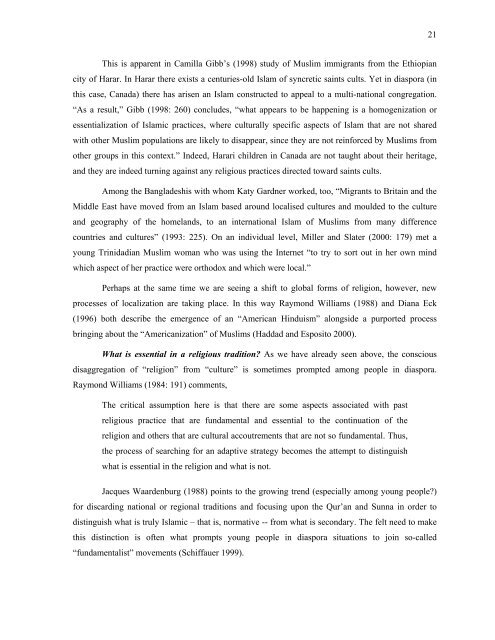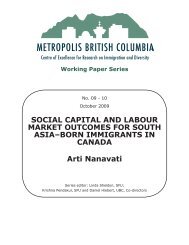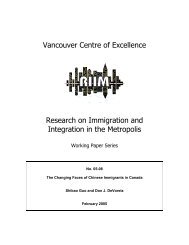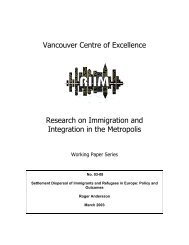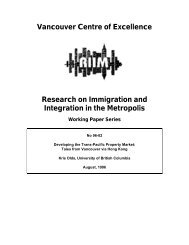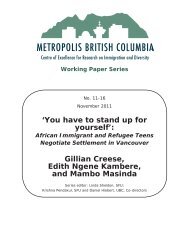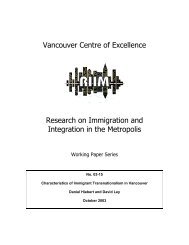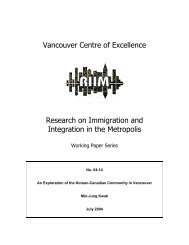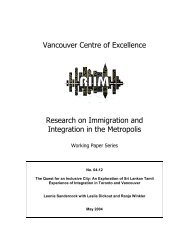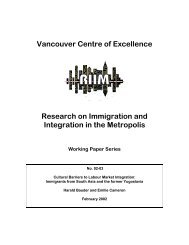Religion in Migration, Diasporas and Transnationalism - Metropolis BC
Religion in Migration, Diasporas and Transnationalism - Metropolis BC
Religion in Migration, Diasporas and Transnationalism - Metropolis BC
Create successful ePaper yourself
Turn your PDF publications into a flip-book with our unique Google optimized e-Paper software.
21<br />
This is apparent <strong>in</strong> Camilla Gibb’s (1998) study of Muslim immigrants from the Ethiopian<br />
city of Harar. In Harar there exists a centuries-old Islam of syncretic sa<strong>in</strong>ts cults. Yet <strong>in</strong> diaspora (<strong>in</strong><br />
this case, Canada) there has arisen an Islam constructed to appeal to a multi-national congregation.<br />
“As a result,” Gibb (1998: 260) concludes, “what appears to be happen<strong>in</strong>g is a homogenization or<br />
essentialization of Islamic practices, where culturally specific aspects of Islam that are not shared<br />
with other Muslim populations are likely to disappear, s<strong>in</strong>ce they are not re<strong>in</strong>forced by Muslims from<br />
other groups <strong>in</strong> this context.” Indeed, Harari children <strong>in</strong> Canada are not taught about their heritage,<br />
<strong>and</strong> they are <strong>in</strong>deed turn<strong>in</strong>g aga<strong>in</strong>st any religious practices directed toward sa<strong>in</strong>ts cults.<br />
Among the Bangladeshis with whom Katy Gardner worked, too, “Migrants to Brita<strong>in</strong> <strong>and</strong> the<br />
Middle East have moved from an Islam based around localised cultures <strong>and</strong> moulded to the culture<br />
<strong>and</strong> geography of the homel<strong>and</strong>s, to an <strong>in</strong>ternational Islam of Muslims from many difference<br />
countries <strong>and</strong> cultures” (1993: 225). On an <strong>in</strong>dividual level, Miller <strong>and</strong> Slater (2000: 179) met a<br />
young Tr<strong>in</strong>idadian Muslim woman who was us<strong>in</strong>g the Internet “to try to sort out <strong>in</strong> her own m<strong>in</strong>d<br />
which aspect of her practice were orthodox <strong>and</strong> which were local.”<br />
Perhaps at the same time we are see<strong>in</strong>g a shift to global forms of religion, however, new<br />
processes of localization are tak<strong>in</strong>g place. In this way Raymond Williams (1988) <strong>and</strong> Diana Eck<br />
(1996) both describe the emergence of an “American H<strong>in</strong>duism” alongside a purported process<br />
br<strong>in</strong>g<strong>in</strong>g about the “Americanization” of Muslims (Haddad <strong>and</strong> Esposito 2000).<br />
What is essential <strong>in</strong> a religious tradition As we have already seen above, the conscious<br />
disaggregation of “religion” from “culture” is sometimes prompted among people <strong>in</strong> diaspora.<br />
Raymond Williams (1984: 191) comments,<br />
The critical assumption here is that there are some aspects associated with past<br />
religious practice that are fundamental <strong>and</strong> essential to the cont<strong>in</strong>uation of the<br />
religion <strong>and</strong> others that are cultural accoutrements that are not so fundamental. Thus,<br />
the process of search<strong>in</strong>g for an adaptive strategy becomes the attempt to dist<strong>in</strong>guish<br />
what is essential <strong>in</strong> the religion <strong>and</strong> what is not.<br />
Jacques Waardenburg (1988) po<strong>in</strong>ts to the grow<strong>in</strong>g trend (especially among young people)<br />
for discard<strong>in</strong>g national or regional traditions <strong>and</strong> focus<strong>in</strong>g upon the Qur’an <strong>and</strong> Sunna <strong>in</strong> order to<br />
dist<strong>in</strong>guish what is truly Islamic – that is, normative -- from what is secondary. The felt need to make<br />
this dist<strong>in</strong>ction is often what prompts young people <strong>in</strong> diaspora situations to jo<strong>in</strong> so-called<br />
“fundamentalist” movements (Schiffauer 1999).


